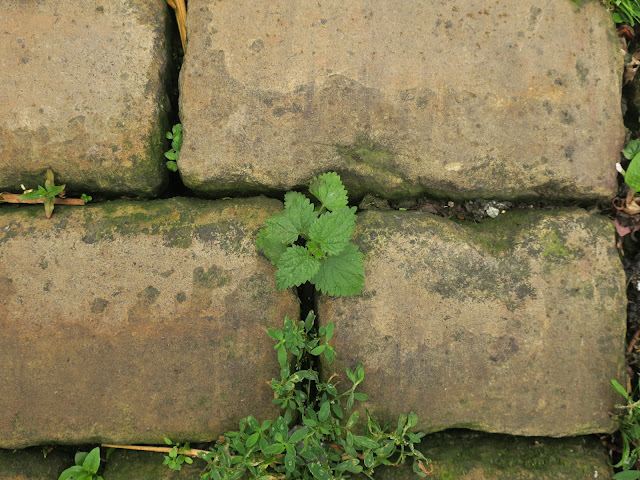 |
| E Mill, Dean Clough. The mills at Dean Clough were built over time. E Mill was built in 1857 |
 |
| Roses and coronavirus street plants at an entrance to Dean Clough, Halifax, Calderdale, England. June 27th 2020 |
 |
| Roses and coronavirus street plants at an entrance to Dean Clough, Halifax, Calderdale, England. June 27th 2020 |
The X is where I live and the vertical line is the Hebble Valley which is so steeply sided in places I think of it as a ravine. Where it meets the base of the triangle there's a huge, renovated mill complex called Dean Clough, which was once one of the largest carpet factories in the world and is now converted into offices, art galleries, a theatre and restaurants. In its hey day, Crossley Carpets employed 5,000 people - the majority of them there. (According to Wikipedia this number was reached in 1900 after nearly a hundred years of manufacturing. According to the 'Let's Look Again' site it didn't reach this number till 1923.) Now, around 4,000 people work in the replacement industries. Or, rather, they do usually. There's a pandemic and the car parks are empty. And this week, because of the rain there are few people wandering around at random. Perfect for my first foray into 'town' for months.
To be blunt, the contents of Dean Clough are not as exciting as they sound on paper (though they could be!) but unlike the residential areas high on the banks either side, it is usually pretty well manicured. The coronovirus is 'seeing to' that and plants are on their way in, springing up between the stone paving slabs in front of the rose beds at one of the access points on the west side.
 |
| Nettle growing through cobbles in street. Halifax, England. June 27th 2020. |
It's a little disconcerting. A bit 'end-of-the-world-ish'.
An extraneous fact:
during the Peterloo Massacre in Manchester (1819) many escaped injury or death because the horses of the Manchester Yeomanry couldn't managed the slippery cobbles of the steep streets in the rain. Manchester is nearly 60 miles away but I think of Peterloo as well as the mill workers in their clogs when I am walking these kinds of streets here. I am amazed the clogs gripped.
LINKS
Dean Clough on Wikipedia
Crossley Carpets on 'Lets Look Again'
Hebble Brook on Wikipedia
Peterloo Massacre on Wikipedia
Manchester Yeomanry on Wikipedia
British Clogs on Wikipedia
Wearing Clogs in Yorkshire in the 1920s on the Bancrofts from Yorkshire Blog
Buying clogs in Calderdale now - the Walkly Clogs site.

13 comments:
We had a surprise plant this summer - in our yard, so not as weird - a new black raspberry bush. I just visited the desert. Plants are tough there too.
Hello Sharon. Having a new raspberry plant arrive by surprise sounds like rather a good thing to happen. I hope you get lots of tasty raspberries from it over time. I've never been to a desert. I imagine it's particularly special experience. And yes, the plants would have to be tough to survive there!
Well it is good to see that the plants are doing well, even if we are not. This week the USA got a rude awakening as the situation is actually worse than when lock-down was initiated. Be careful on those slippery cobbles!
Hello Kenneth. I am sorry to read that. Is there an accepted explanation about why the pandemic is getting worse despite the lockdown? Yes, I am ultra-careful on the cobbles. My left arm, which broke when I fell in winter snow, is still so painful I don't want to risk falling again anywhere!
It always amazes me to see such beautiful plants or flowers popping up between the cracks. Nice photos Lucy. Stay safe and have a wonderful evening.
Yesterday on Youtube I came across some clog dancing. Fun to watch for a few minutes.
Well, I don't know about mills and factories, but you certainly have an industrial-grade noticing ability, Lucy! I had to scroll back up the page and stare at the nettle photograph, and the other plants contained therein. I'm not so great with plant ID, but if I 'weed' something from the veg plot, I feel I ought to know what it is before I hoick it out. Over on the far left is a Willowherb of some sort, I think, but the plant at the bottom has me puzzled. Could be one of the Sorrels, or a Redshank maybe?
You are nothing if not well-organized, Lucy. The flowers seem to be thriving, and the cobbled streets add a level of charm to the whole scene. As for weeds, welcome to all of them, I say!
Hi there - have you seem the 'trend' where people use chalk to write the names of 'weeds' that are growing in urban areas? So you go for a walk and there is "hen bit" or "Ivy-leafed Toad Flax" (a personal favourite) written in the pavement.
Hope all is well - Stewart M - Melbourne
It's lovely to see the flowers popping up in the cracks
I am always happy to see a plant popping out of stone, gravel, and other places where they should not by rights be. It reassures me that nature, not man, really is in control. We just think we're the boss. Love that tomato plant!
There are some lovely bits growing through the stones, as well as nice surprises like the enterprising opportunity tomato. That last picture does look sort of apocalyptic!
Walkleys Clogs haven't been in business for a long time. The mill was made into apartments years ago
Post a Comment